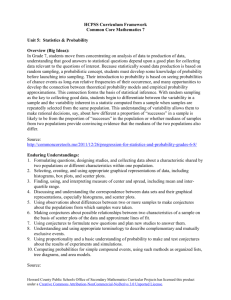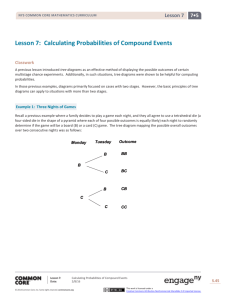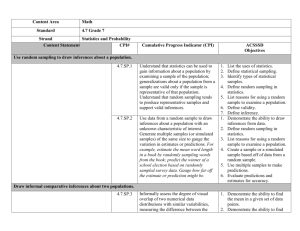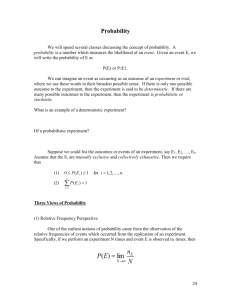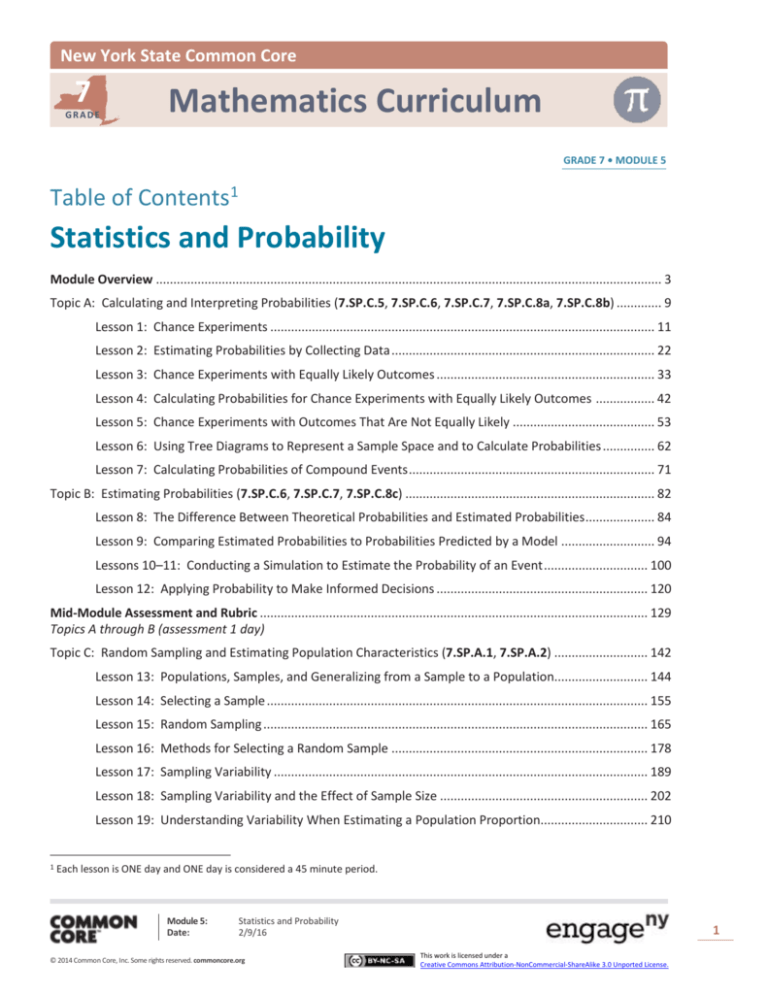
New York State Common Core
7
GRADE
Mathematics Curriculum
GRADE 7 • MODULE 5
Table of Contents1
Statistics and Probability
Module Overview .................................................................................................................................................. 3
Topic A: Calculating and Interpreting Probabilities (7.SP.C.5, 7.SP.C.6, 7.SP.C.7, 7.SP.C.8a, 7.SP.C.8b) ............. 9
Lesson 1: Chance Experiments ............................................................................................................... 11
Lesson 2: Estimating Probabilities by Collecting Data ............................................................................ 22
Lesson 3: Chance Experiments with Equally Likely Outcomes ............................................................... 33
Lesson 4: Calculating Probabilities for Chance Experiments with Equally Likely Outcomes ................. 42
Lesson 5: Chance Experiments with Outcomes That Are Not Equally Likely ......................................... 53
Lesson 6: Using Tree Diagrams to Represent a Sample Space and to Calculate Probabilities ............... 62
Lesson 7: Calculating Probabilities of Compound Events ....................................................................... 71
Topic B: Estimating Probabilities (7.SP.C.6, 7.SP.C.7, 7.SP.C.8c) ........................................................................ 82
Lesson 8: The Difference Between Theoretical Probabilities and Estimated Probabilities .................... 84
Lesson 9: Comparing Estimated Probabilities to Probabilities Predicted by a Model ........................... 94
Lessons 10–11: Conducting a Simulation to Estimate the Probability of an Event .............................. 100
Lesson 12: Applying Probability to Make Informed Decisions ............................................................. 120
Mid-Module Assessment and Rubric ................................................................................................................ 129
Topics A through B (assessment 1 day)
Topic C: Random Sampling and Estimating Population Characteristics (7.SP.A.1, 7.SP.A.2) ........................... 142
Lesson 13: Populations, Samples, and Generalizing from a Sample to a Population........................... 144
Lesson 14: Selecting a Sample .............................................................................................................. 155
Lesson 15: Random Sampling ............................................................................................................... 165
Lesson 16: Methods for Selecting a Random Sample .......................................................................... 178
Lesson 17: Sampling Variability ............................................................................................................ 189
Lesson 18: Sampling Variability and the Effect of Sample Size ............................................................ 202
Lesson 19: Understanding Variability When Estimating a Population Proportion............................... 210
1
Each lesson is ONE day and ONE day is considered a 45 minute period.
Module 5:
Date:
Statistics and Probability
2/9/16
© 2014 Common Core, Inc. Some rights reserved. commoncore.org
1
This work is licensed under a
Creative Commons Attribution-NonCommercial-ShareAlike 3.0 Unported License.
NYS COMMON CORE MATHEMATICS CURRICULUM
Module Overview
7•5
Lesson 20: Estimating a Population Proportion ................................................................................... 220
Topic D: Comparing Populations (7.SP.B.3, 7.SP.B.4) ....................................................................................... 235
Lesson 21: Why Worry About Sampling Variability? ............................................................................ 236
Lessons 22–23: Using Sample Data to Compare the Means of Two or More Populations .................. 249
End-of-Module Assessment and Rubric ............................................................................................................ 278
Topics A through D (assessment 1 day)
Module 5:
Date:
Statistics and Probability
2/9/16
© 2014 Common Core, Inc. Some rights reserved. commoncore.org
2
This work is licensed under a
Creative Commons Attribution-NonCommercial-ShareAlike 3.0 Unported License.
Module Overview
NYS COMMON CORE MATHEMATICS CURRICULUM
7•5
Grade 7 • Module 5
Statistics and Probability
OVERVIEW
In this module, students begin their study of probability, learning how to interpret probabilities and how to
compute probabilities in simple settings. They also learn how to estimate probabilities empirically. The
concept of probability provides a foundation for the thinking required to make inferential reasoning that will
be developed in the second half of this module. Additionally, students build on their knowledge of data
distributions that they studied in Grade 6, compare data distributions of two or more populations, and are
introduced to the idea of drawing informal inferences based on data collected from random samples.
In Topics A and B, students learn to interpret the probability of an event as the proportion of the time that
the event will occur when a chance experiment is repeated many times (7.SP.C.5). They learn to compute or
estimate probabilities using a variety of methods, including collecting data, using tree diagrams, and using
simulations. In Topic B, students move to comparing probabilities from simulations to computed probabilities
that are based on theoretical models (7.SP.C.6, 7.SP.C.7). They calculate probabilities of compound events
using lists, tables, tree diagrams, and simulations (7.SP.C.8). They learn to use probabilities to make decisions
and to determine whether or not a given probability model is plausible (7.SP.C.7). The Mid-Module
Assessment follows Topic B.
In Topics C and D, students focus on using random sampling to draw informal inferences about a population
(7.SP.A.1, 7.SP.A.2). In Topic C, they investigate sampling from a population (7.SP.A.2). They learn to
estimate a population mean using numerical data from a random sample (7.SP.A.2). They also learn how to
estimate a population proportion using categorical data from a random sample. In Topic D, students learn to
compare two populations with similar variability. They learn to consider sampling variability when deciding if
there is evidence that the means or the proportions of two populations are actually different (7.SP.B.3,
7.SP.B.4). The End-of-Module Assessment follows Topic D.
Focus Standards
Using random sampling to draw inferences about a population.
7.SP.A.1
Understand that statistics can be used to gain information about a population by examining
a sample of the population; generalizations about a population from a sample are valid only
if the sample is representative of that population. Understand that random sampling tends
to produce representative samples and support valid inferences.
Module 5:
Date:
Statistics and Probability
2/9/16
© 2014 Common Core, Inc. Some rights reserved. commoncore.org
3
This work is licensed under a
Creative Commons Attribution-NonCommercial-ShareAlike 3.0 Unported License.
Module Overview
NYS COMMON CORE MATHEMATICS CURRICULUM
7.SP.A.2
7•5
Use data from a random sample to draw inferences about a population with an unknown
characteristic of interest. Generate multiple samples (or simulated samples) of the same
size to gauge the variation in estimates or predictions. For example, estimate the mean
word length in a book by randomly sampling words from the book; predict the winner of a
school election based on randomly sampled survey data. Gauge how far off the estimate or
prediction might be.
Draw informal comparative inferences about two populations.
7.SP.B.3
Informally assess the degree of visual overlap of two numerical data distributions with
similar variability, measuring the difference between the centers by expressing it as a
multiple of a measure of variability. For example, the mean height of players on the
basketball team is 10 cm greater than the mean height of players on the soccer team, about
twice the variability (mean absolute deviation) on either team; on a dot plot, the separation
between the two distributions of heights is noticeable.
7.SP.B.4
Use measures of center and measures of variability for numerical data from random
samples to draw informal comparative inferences about two populations. For example,
decide whether the words in a chapter of a seventh-grade science book are generally longer
than the words in a chapter of a fourth-grade science book.
Investigate chance processes and develop, use, and evaluate probability models.
7.SP.C.5
Understand that the probability of a chance event is a number between 0 and 1 that
expresses the likelihood of the event occurring. Larger numbers indicate greater likelihood.
A probability near 0 indicates an unlikely event, a probability around 1/2 indicates an event
that is neither unlikely nor likely, and a probability near 1 indicates a likely event.
7.SP.C.6
Approximate the probability of a chance event by collecting data on the chance process that
produces it and observing its long-run relative frequency, and predict the approximate
relative frequency given the probability. For example, when rolling a number cube 600
times, predict that a 3 or 6 would be rolled roughly 200 times, but probably not exactly 200
times.
7.SP.C.7
Develop a probability model and use it to find probabilities of events. Compare probabilities
from a model to observed frequencies; if the agreement is not good, explain possible
sources of the discrepancy.
a.
Develop a uniform probability model by assigning equal probability to all outcomes, and
use the model to determine probabilities of events. For example, if a student is selected
at random from a class, find the probability that Jane will be selected and the
probability that a girl will be selected.
b.
Develop a probability model (which may not be uniform) by observing frequencies in
data generated from a chance process. For example, find the approximate probability
that a spinning penny will land heads up or that a tossed paper cup will land open-end
down. Do the outcomes for the spinning penny appear to be equally likely based on the
observed frequencies?
Module 5:
Date:
Statistics and Probability
2/9/16
© 2014 Common Core, Inc. Some rights reserved. commoncore.org
4
This work is licensed under a
Creative Commons Attribution-NonCommercial-ShareAlike 3.0 Unported License.
NYS COMMON CORE MATHEMATICS CURRICULUM
7.SP.C.8
Module Overview
7•5
Find probabilities of compound events using organized lists, tables, tree diagrams, and
simulation.
a.
Understand that, just as with simple events, the probability of a compound event is the
fraction of outcomes in the sample space for which the compound event occurs.
b.
Represent sample spaces for compound events using methods such as organized lists,
tables and tree diagrams. For an event described in everyday language (e.g., “rolling
double sixes”), identify the outcomes in the sample space which compose the event.
c.
Design and use a simulation to generate frequencies for compound events. For
example, use random digits as a simulation tool to approximate the answer to the
question: If 40% of donors have type A blood, what is the probability that it will take at
least 4 donors to find one with type A blood?
Foundational Standards
Summarize and describe distributions.
6.SP.B.5
Summarize numerical data sets in relation to their context, such as by:
a.
Reporting the number of observations.
b.
Describing the nature of the attribute under investigation, including how it was
measured and its units of measurement.
c.
Giving quantitative measures of center (median and/or mean) and variability
(interquartile range and/or mean absolute deviation), as well as describing any overall
pattern and any striking deviations from the overall pattern with reference to the
context in which the data were gathered.
d.
Relating the choice of measures of center and variability to the shape of the data
distribution and the context in which the data were gathered.
Understand ratio concepts and use ratio reasoning to solve problems.
6.RP.A.3c
Find a percent of a quantity as a rate per 100 (e.g., 30% of a quantity means 30/100 times
the quantity); solve problems involving finding the whole, given a part and the percent.
Analyze proportional relationships and use them to solve real-world and mathematical
problems.
7.RP.A.2
Recognize and represent proportional relationships between quantities.
Module 5:
Date:
Statistics and Probability
2/9/16
© 2014 Common Core, Inc. Some rights reserved. commoncore.org
5
This work is licensed under a
Creative Commons Attribution-NonCommercial-ShareAlike 3.0 Unported License.
Module Overview
NYS COMMON CORE MATHEMATICS CURRICULUM
7•5
Focus Standards for Mathematical Practice
MP.2
Reason abstractly and quantitatively. Students reason quantitatively by posing statistical
questions about variables and the relationship between variables. Students reason
abstractly about chance experiments by analyzing possible outcomes and designing
simulations to estimate probabilities.
MP.3
Construct viable arguments and critique the reasoning of others. Students construct viable
arguments by using sample data to explore conjectures about a population. Students
critique the reasoning of other students as part of poster or similar presentations.
MP.4
Model with mathematics. Students use probability models to describe outcomes of chance
experiments. They evaluate probability models by calculating the theoretical probabilities
of chance events, and by comparing these probabilities to observed relative frequencies.
MP.5
Use appropriate tools strategically. Students use simulation to approximate probabilities.
Students use appropriate technology to calculate measures of center and variability.
Students use graphical displays to visually represent distributions.
MP.6
Attend to precision. Students interpret and communicate conclusions in context based on
graphical and numerical data summaries. Students make appropriate use of statistical
terminology.
Terminology
New or Recently Introduced Terms
Compound Event (A compound event is an event consisting of more than one outcome from the
sample space of a chance experiment.)
Inference (Inference is the act of drawing conclusions about a population using data from a sample.)
Long-Run Relative Frequency (The proportion of the time some outcome occurs in a very long
sequence of observations is called a long-run relative frequency.)
Probability (Probability is a number between 0 and 1 that represents the likelihood that an outcome
will occur.)
Probability Model (A probability model for a chance experiment specifies the set of possible
outcomes of the experiment—the sample space—and the probability associated with each
outcome.)
Random Sample (A random sample is a sample selected in a way that gives every different possible
sample of the same size an equal chance of being selected.)
Simulation (A simulation is the process of generating “artificial” data that are consistent with a given
probability model or with sampling from a known population.)
Module 5:
Date:
Statistics and Probability
2/9/16
© 2014 Common Core, Inc. Some rights reserved. commoncore.org
6
This work is licensed under a
Creative Commons Attribution-NonCommercial-ShareAlike 3.0 Unported License.
Module Overview
NYS COMMON CORE MATHEMATICS CURRICULUM
7•5
Tree Diagram (A tree diagram consists of a sequence of nodes and branches. Tree diagrams are
sometimes used as a way of representing the outcomes of a chance experiment that consists of a
sequence of steps, such as rolling two number cubes, viewed as first rolling one number cube and
then rolling the second.)
Uniform Probability Model (A uniform probability model is a probability model in which all
outcomes in the sample space of a chance experiment are equally likely.)
Familiar Terms and Symbols2
Mean Absolute Deviation (MAD)
Measures of Center
Measures of Variability
Shape
Suggested Tools and Representations
Graphing Calculator (See example below.)
Dot Plots (See example below.)
Histograms (See example below.)
Dot Plot
Graphing Calculator
Histogram
2
These are terms and symbols students have seen previously.
Module 5:
Date:
Statistics and Probability
2/9/16
© 2014 Common Core, Inc. Some rights reserved. commoncore.org
7
This work is licensed under a
Creative Commons Attribution-NonCommercial-ShareAlike 3.0 Unported License.
Module Overview
NYS COMMON CORE MATHEMATICS CURRICULUM
7•5
Assessment Summary
Assessment Type Administered
Mid-Module
Assessment Task
End-of-Module
Assessment Task
After Topic B
After Topic D
Module 5:
Date:
Format
Standards Addressed
Constructed response with rubric
7.SP.C.5, 7.SP.C.6,
7.SP.C.7, 7.SP.C.8
Constructed response with rubric
7.SP.A.1, 7.SP.A.2,
7.SP.B.3, 7.SP.B.4,
7.SP.C.5, 7.SP.C.6,
7.SP.C.7, 7.SP.C.8
Statistics and Probability
2/9/16
© 2014 Common Core, Inc. Some rights reserved. commoncore.org
8
This work is licensed under a
Creative Commons Attribution-NonCommercial-ShareAlike 3.0 Unported License.

